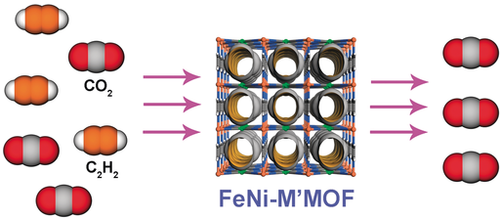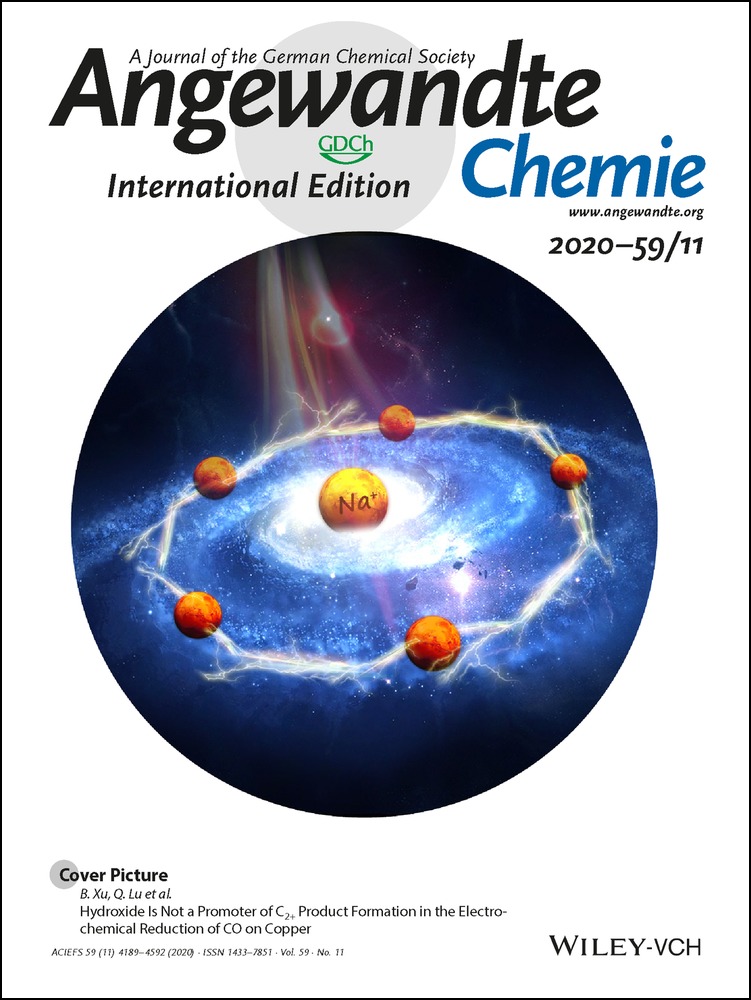Mixed Metal–Organic Framework with Multiple Binding Sites for Efficient C2H2/CO2 Separation
Corresponding Author
Prof. Junkuo Gao
Institute of Functional Porous Materials, The Key laboratory of Advanced Textile Materials and Manufacturing Technology of Ministry of Education, School of Materials Science and Engineering, Zhejiang Sci-Tech University, Hangzhou, 310018 China
Department of Chemistry, University of Texas at San Antonio, One UTSA Circle, San Antonio, TX, 78249-0698 USA
Search for more papers by this authorXuefeng Qian
Institute of Functional Porous Materials, The Key laboratory of Advanced Textile Materials and Manufacturing Technology of Ministry of Education, School of Materials Science and Engineering, Zhejiang Sci-Tech University, Hangzhou, 310018 China
Search for more papers by this authorCorresponding Author
Dr. Rui-Biao Lin
Department of Chemistry, University of Texas at San Antonio, One UTSA Circle, San Antonio, TX, 78249-0698 USA
Search for more papers by this authorDr. Rajamani Krishna
Van't Hoff Institute of Molecular Sciences, University of Amsterdam, Science Park 904, 1098 XH, Amsterdam, The Netherlands
Search for more papers by this authorDr. Hui Wu
NIST Center for Neutron Research, National Institute of Standards and Technology, Gaithersburg, MD, 20899-6102 USA
Search for more papers by this authorCorresponding Author
Dr. Wei Zhou
NIST Center for Neutron Research, National Institute of Standards and Technology, Gaithersburg, MD, 20899-6102 USA
Search for more papers by this authorCorresponding Author
Prof. Banglin Chen
Department of Chemistry, University of Texas at San Antonio, One UTSA Circle, San Antonio, TX, 78249-0698 USA
Search for more papers by this authorCorresponding Author
Prof. Junkuo Gao
Institute of Functional Porous Materials, The Key laboratory of Advanced Textile Materials and Manufacturing Technology of Ministry of Education, School of Materials Science and Engineering, Zhejiang Sci-Tech University, Hangzhou, 310018 China
Department of Chemistry, University of Texas at San Antonio, One UTSA Circle, San Antonio, TX, 78249-0698 USA
Search for more papers by this authorXuefeng Qian
Institute of Functional Porous Materials, The Key laboratory of Advanced Textile Materials and Manufacturing Technology of Ministry of Education, School of Materials Science and Engineering, Zhejiang Sci-Tech University, Hangzhou, 310018 China
Search for more papers by this authorCorresponding Author
Dr. Rui-Biao Lin
Department of Chemistry, University of Texas at San Antonio, One UTSA Circle, San Antonio, TX, 78249-0698 USA
Search for more papers by this authorDr. Rajamani Krishna
Van't Hoff Institute of Molecular Sciences, University of Amsterdam, Science Park 904, 1098 XH, Amsterdam, The Netherlands
Search for more papers by this authorDr. Hui Wu
NIST Center for Neutron Research, National Institute of Standards and Technology, Gaithersburg, MD, 20899-6102 USA
Search for more papers by this authorCorresponding Author
Dr. Wei Zhou
NIST Center for Neutron Research, National Institute of Standards and Technology, Gaithersburg, MD, 20899-6102 USA
Search for more papers by this authorCorresponding Author
Prof. Banglin Chen
Department of Chemistry, University of Texas at San Antonio, One UTSA Circle, San Antonio, TX, 78249-0698 USA
Search for more papers by this authorGraphical Abstract
Mix it up: Reported here is a mixed metal–organic framework (M′MOF), [Fe(pyz)Ni(CN)4] (FeNi-M′MOF, pyz=pyrazine), with multiple functional sites and compact one-dimensional channels of about 4.0 Å. FeNi-M′MOF, with a microporous one-dimensional channel decorated with multiple binding sites, shows a high C2H2 uptake (133 cm3 cm−3) and high C2H2/CO2 selectivity (24).
Abstract
The separation of C2H2/CO2 is particularly challenging owing to their similarities in physical properties and molecular sizes. Reported here is a mixed metal–organic framework (M′MOF), [Fe(pyz)Ni(CN)4] (FeNi-M′MOF, pyz=pyrazine), with multiple functional sites and compact one-dimensional channels of about 4.0 Å for C2H2/CO2 separation. This MOF shows not only a remarkable volumetric C2H2 uptake of 133 cm3 cm−3, but also an excellent C2H2/CO2 selectivity of 24 under ambient conditions, resulting in the second highest C2H2-capture amount of 4.54 mol L−1, thus outperforming most previous benchmark materials. The separation performance of this material is driven by π–π stacking and multiple intermolecular interactions between C2H2 molecules and the binding sites of FeNi-M′MOF. This material can be facilely synthesized at room temperature and is water stable, highlighting FeNi-M′MOF as a promising material for C2H2/CO2 separation.
Supporting Information
As a service to our authors and readers, this journal provides supporting information supplied by the authors. Such materials are peer reviewed and may be re-organized for online delivery, but are not copy-edited or typeset. Technical support issues arising from supporting information (other than missing files) should be addressed to the authors.
| Filename | Description |
|---|---|
| anie202000323-sup-0001-misc_information.pdf1.5 MB | Supplementary |
Please note: The publisher is not responsible for the content or functionality of any supporting information supplied by the authors. Any queries (other than missing content) should be directed to the corresponding author for the article.
References
- 1
- 1aH. Li, L. Li, R.-B. Lin, W. Zhou, S. Xiang, B. Chen, Z. Zhang, EnergyChem 2019, 1, 100006;
10.1016/j.enchem.2019.100006 Google Scholar
- 1bM. Ding, R. W. Flaig, H.-L. Jiang, O. M. Yaghi, Chem. Soc. Rev. 2019, 48, 2783–2828;
- 1cR.-B. Lin, L. Li, H.-L. Zhou, H. Wu, C. He, S. Li, R. Krishna, J. Li, W. Zhou, B. Chen, Nat. Mater. 2018, 17, 1128–1133;
- 1dM. K. Taylor, T. Runčevski, J. Oktawiec, J. E. Bachman, R. L. Siegelman, H. Jiang, J. A. Mason, J. D. Tarver, J. R. Long, J. Am. Chem. Soc. 2018, 140, 10324–10331;
- 1eX. Cui, K. Chen, H. Xing, Q. Yang, R. Krishna, Z. Bao, H. Wu, W. Zhou, X. Dong, Y. Han, B. Li, Q. Ren, M. J. Zaworotko, B. Chen, Science 2016, 353, 141–144;
- 1fA. Cadiau, K. Adil, P. M. Bhatt, Y. Belmabkhout, M. Eddaoudi, Science 2016, 353, 137–140;
- 1gR.-B. Lin, S. Xiang, W. Zhou, B. Chen, Chem 2019, https://doi.org/10.1016/j.chempr.2019.1010.1012.
- 2
- 2aK.-J. Chen, D. G. Madden, S. Mukherjee, T. Pham, K. A. Forrest, A. Kumar, B. Space, J. Kong, Q.-Y. Zhang, M. J. Zaworotko, Science 2019, 366, 241–246;
- 2bY. Liu, Z. Chen, G. Liu, Y. Belmabkhout, K. Adil, M. Eddaoudi, W. Koros, Adv. Mater. 2019, 31, 1807513;
- 2cW. G. Cui, T. L. Hu, X. H. Bu, Adv. Mater. 2019, 31, 1806445;
- 2dR. L. Siegelman, P. J. Milner, E. J. Kim, S. C. Weston, J. R. Long, Energy Environ. Sci. 2019, 12, 2161–2173;
- 2eL. Li, R.-B. Lin, R. Krishna, H. Li, S. Xiang, H. Wu, J. Li, W. Zhou, B. Chen, Science 2018, 362, 443–446;
- 2fP.-Q. Liao, N.-Y. Huang, W.-X. Zhang, J.-P. Zhang, X.-M. Chen, Science 2017, 356, 1193–1196;
- 2gS. Yang, A. J. Ramirez-Cuesta, R. Newby, V. Garcia-Sakai, P. Manuel, S. K. Callear, S. I. Campbell, C. C. Tang, M. Schröder, Nat. Chem. 2014, 7, 121–129;
- 2hM. L. Aubrey, M. T. Kapelewski, J. F. Melville, J. Oktawiec, D. Presti, L. Gagliardi, J. R. Long, J. Am. Chem. Soc. 2019, 141, 5005–5013.
- 3C. R. Reid, K. M. Thomas, J. Phys. Chem. B 2001, 105, 10619–10629.
- 4
- 4aH. Yang, T. X. Trieu, X. Zhao, Y. Wang, Y. Wang, P. Feng, X. Bu, Angew. Chem. Int. Ed. 2019, 58, 11757–11762; Angew. Chem. 2019, 131, 11883–11888;
- 4bJ. Lee, C. Y. Chuah, J. Kim, Y. Kim, N. Ko, Y. Seo, K. Kim, T. H. Bae, E. Lee, Angew. Chem. Int. Ed. 2018, 57, 7869–7873; Angew. Chem. 2018, 130, 7995–7999;
- 4cR.-B. Lin, L. Li, H. Wu, H. Arman, B. Li, R.-G. Lin, W. Zhou, B. Chen, J. Am. Chem. Soc. 2017, 139, 8022–8028;
- 4dM. Jiang, X. Cui, L. Yang, Q. Yang, Z. Zhang, Y. Yang, H. Xing, Chem. Eng. J. 2018, 352, 803–810;
- 4eH. S. Scott, M. Shivanna, A. Bajpai, D. G. Madden, K.-J. Chen, T. Pham, K. A. Forrest, A. Hogan, B. Space, J. J. Perry IV, M. J. Zaworotko, ACS Appl. Mater. Interfaces 2017, 9, 33395–33400;
- 4fK.-J. Chen, H. S. Scott, D. G. Madden, T. Pham, A. Kumar, A. Bajpai, M. Lusi, K. A. Forrest, B. Space, J. J. Perry IV, M. J. Zaworotko, Chem 2016, 1, 753–765;
- 4gO. T. Qazvini, R. Babarao, Z.-L. Shi, Y.-B. Zhang, S. G. Telfer, J. Am. Chem. Soc. 2019, 141, 5014–5020.
- 5
- 5aH. Zeng, M. Xie, Y.-L. Huang, Y. Zhao, X.-J. Xie, J.-P. Bai, M.-Y. Wan, R. Krishna, W. Lu, D. Li, Angew. Chem. Int. Ed. 2019, 58, 8515–8519; Angew. Chem. 2019, 131, 8603–8607;
- 5bJ. Duan, M. Higuchi, J. Zheng, S.-I. Noro, I.-Y. Chang, K. Hyeon-Deuk, S. Mathew, S. Kusaka, E. Sivaniah, R. Matsuda, J. Am. Chem. Soc. 2017, 139, 11576–11583;
- 5cF. Luo, C. Yan, L. Dang, R. Krishna, W. Zhou, H. Wu, X. Dong, Y. Han, T.-L. Hu, M. O'Keeffe, L. Wang, M. Luo, R.-B. Lin, B. Chen, J. Am. Chem. Soc. 2016, 138, 5678–5684.
- 6
- 6aY.-L. Peng, T. Pham, P. Li, T. Wang, Y. Chen, K.-J. Chen, K. A. Forrest, B. Space, P. Cheng, M. J. Zaworotko, Z. Zhang, Angew. Chem. Int. Ed. 2018, 57, 10971–10975; Angew. Chem. 2018, 130, 11137–11141;
- 6bY.-P. Li, Y. Wang, Y.-Y. Xue, H.-P. Li, Q.-G. Zhai, S.-N. Li, Y.-C. Jiang, M.-C. Hu, X. Bu, Angew. Chem. Int. Ed. 2019, 58, 13590–13595; Angew. Chem. 2019, 131, 13724–13729;
- 6cY. Ye, Z. Ma, R.-B. Lin, R. Krishna, W. Zhou, Q. Lin, Z. Zhang, S. Xiang, B. Chen, J. Am. Chem. Soc. 2019, 141, 4130–4136.
- 7
- 7aD. Aguilà, Y. Prado, E. S. Koumousi, C. Mathoniere, R. Clérac, Chem. Soc. Rev. 2016, 45, 203–224;
- 7bM. B. Zakaria, T. Chikyow, Coord. Chem. Rev. 2017, 352, 328–345;
- 7cK. Otsubo, T. Haraguchi, H. Kitagawa, Coord. Chem. Rev. 2017, 346, 123–138;
- 7dS. Sakaida, K. Otsubo, O. Sakata, C. Song, A. Fujiwara, M. Takata, H. Kitagawa, Nat. Chem. 2016, 8, 377–383;
- 7eM. M. Deshmukh, M. Ohba, S. Kitagawa, S. Sakaki, J. Am. Chem. Soc. 2013, 135, 4840–4849;
- 7fJ. T. Culp, M. R. Smith, E. Bittner, B. Bockrath, J. Am. Chem. Soc. 2008, 130, 12427–12434.
- 8
- 8aM. C. Das, S. Xiang, Z. Zhang, B. Chen, Angew. Chem. Int. Ed. 2011, 50, 10510–10520; Angew. Chem. 2011, 123, 10696–10707;
- 8bS.-C. Xiang, Z. Zhang, C.-G. Zhao, K. Hong, X. Zhao, D.-R. Ding, M.-H. Xie, C.-D. Wu, M. C. Das, R. Gill, K. Tomas, B. Chen, Nat. Commun. 2011, 2, 204.
- 9V. Niel, J. M. Martinez-Agudo, M. C. Muñoz, A. B. Gaspar, J. A. Real, Inorg. Chem. 2001, 40, 3838–3839.
- 10J. Gao, J. Cong, Y. Wu, L. Sun, J. Yao, B. Chen, ACS Appl. Energy Mater. 2018, 1, 5140–5144.
- 11X. Duan, Q. Zhang, J. Cai, Y. Yang, Y. Cui, Y. He, C. Wu, R. Krishna, B. Chen, G. Qian, J. Mater. Chem. A 2014, 2, 2628–2633.
- 12J. Duan, W. Jin, R. Krishna, Inorg. Chem. 2015, 54, 4279–4284.
- 13S. Xiang, W. Zhou, Z. Zhang, M. A. Green, Y. Liu, B. Chen, Angew. Chem. Int. Ed. 2010, 49, 4615–4618; Angew. Chem. 2010, 122, 4719–4722.
- 14P. Li, Y. He, Y. Zhao, L. Weng, H. Wang, R. Krishna, H. Wu, W. Zhou, M. O'Keeffe, Y. Han, B. Chen, Angew. Chem. Int. Ed. 2015, 54, 574–577; Angew. Chem. 2015, 127, 584–587.
- 15Y. He, R. Krishna, B. Chen, Energy Environ. Sci. 2012, 5, 9107–9120.
- 16E. D. Bloch, W. L. Queen, R. Krishna, J. M. Zadrozny, C. M. Brown, J. R. Long, Science 2012, 335, 1606–1610.





